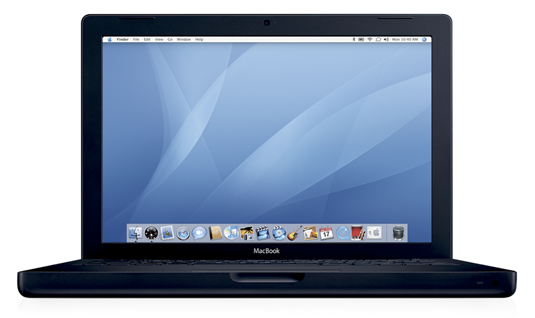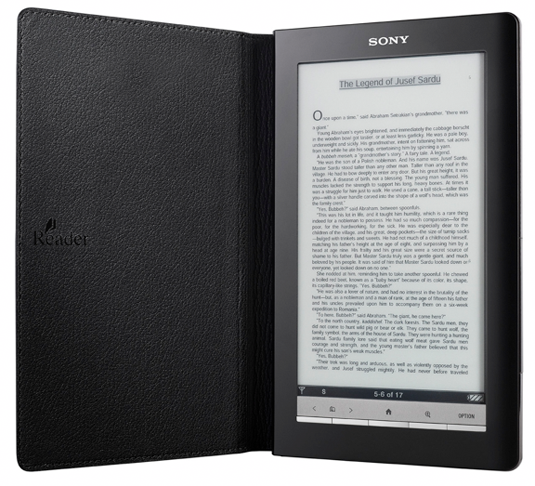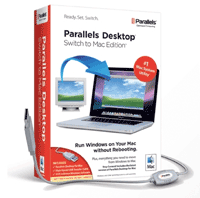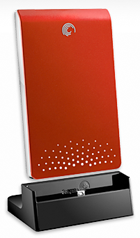Like 5Words? Subscribe via RSS.
Snow Leopard gets malware blocker.
Science says multitasking is bad.
Like 5Words? Subscribe via RSS.
Snow Leopard gets malware blocker.
Science says multitasking is bad.
 Robert S. Anthony of The Paper PC has a fun post up about a new Wi-Fi reading room at the New York Public Library. It’s an “elegant” venue with seats for up to 128 laptop users–and if you don’t have a netbook, they’ll loan you one. Sounds fabulous–except there are no power outlets at the seats. If you’re using the Wi-Fi you’re draining your battery.
Robert S. Anthony of The Paper PC has a fun post up about a new Wi-Fi reading room at the New York Public Library. It’s an “elegant” venue with seats for up to 128 laptop users–and if you don’t have a netbook, they’ll loan you one. Sounds fabulous–except there are no power outlets at the seats. If you’re using the Wi-Fi you’re draining your battery.
The NYPL is in excellent company. Wi-Fi blankets much of our public spaces these days, but power outlets are still hard to find. Many airline terminals seem to have a total of about three outlets, none of them especially convenient to the seating (which is why you’ll often find me camping out on the carpet while I wait for a plane). Some airports now have Samsung-sponsored power “trees,” which is far better than nothing–but they’re bizarrely configured in a way that makes it difficult to plug in a laptop and use it. (Don’t even get me started on most airplanes–yes, I’m looking at you, United.)
Starbucks? Everybody gets two hours of free Wi-Fi a day, but my local one has two power jacks, both at tables usually occupied by people who don’t need them. Hotels sometimes do a bit better, but the average tech-centric conference here in the Bay Area has maybe one outlet per fifty MacBook Pro-toting attendees. Almost everywhere I go, I’m keenly aware that most of our buildings date from the age before large numbers of people toted portable computers with them. (And even structures built recently usually have a shortage of alternating current.)
I know that installing outlets isn’t always cheap and easy. I still long for the day when they’re everywhere. (Literally, almost–one per seat wouldn’t be baf.) But I kinda wonder whether the point will be made moot by laptops with battery lives so long that plugging in becomes less essential. Me, I want fifty hours on a charge…
![]() Lazyfeed, a Web service with good buzz, has opened up and is available to all today. It’s a browser-based tool for reading items from RSS feeds with an interesting premise: What if items were organized not by the originating feed (here’s Technologizer’s) but by topic–and were updated in real time? Like many brand-new services, it seems to be suffering some launch-day hiccups at the moment–it’s a bit sluggish, and is giving me some errors. But it’s still worth checking out.
Lazyfeed, a Web service with good buzz, has opened up and is available to all today. It’s a browser-based tool for reading items from RSS feeds with an interesting premise: What if items were organized not by the originating feed (here’s Technologizer’s) but by topic–and were updated in real time? Like many brand-new services, it seems to be suffering some launch-day hiccups at the moment–it’s a bit sluggish, and is giving me some errors. But it’s still worth checking out.
Once you’ve signed up for Lazyfeed, you can tell it what you’re interested in by connecting it to blogs you like, and your accounts for Twitter, Facebook, Delicious, and/or Flickr; you can also simply enter tags for subjects that matter to you, such as firefox, microsoftoffice, iphone, or palmpre. Lazyfeed then builds a list of tags for your topics and lets you peruse blog posts and articles that relate to them, and updates it continuously. (You can also save items for later reference.)

The emphasis in Lazyfeed is very much on the newest stuff rather than the ones that are most relevant or from the biggest sources–for instance, the last time I checked the feed for “microsoftoffice,” the first item I saw was a job listing from a company seeking a secretary with Microsoft Office experience. I’d like Lazyfeed even better if the most worthwhile items on a topic were easier to find; maybe it’ll get better at filtering them for me as I use it more. I’m already finding it useful, though, especially for discovering items from sources that aren’t on my menu of feeds over at Google Reader–and which sometimes come from sites I’ve never heard of. Lazyfeed isn’t meant to replace Google Reader or other standard RSS readers, although I could easily see it adding enough browse-by-source functionality to make it a substitute for a typical RSS reader rather than a complement.
If you give the service a whirl, let us know what you think.
 AppleInsider is reporting that Apple is working on refreshing the $999 white MacBook that’s its cheapest portable computer–and, AppleInsider, reports, still a best-seller. Makes sense to me. I’m assuming we’ll see one with new (but economical) specs, a better display, a sealed battery with longer battery life, and an SD reader. Timing? Probably early next year, whenever Apple decides to announce the products it’s not going to be rolling out at Macworld Expo.
AppleInsider is reporting that Apple is working on refreshing the $999 white MacBook that’s its cheapest portable computer–and, AppleInsider, reports, still a best-seller. Makes sense to me. I’m assuming we’ll see one with new (but economical) specs, a better display, a sealed battery with longer battery life, and an SD reader. Timing? Probably early next year, whenever Apple decides to announce the products it’s not going to be rolling out at Macworld Expo.
It’s also only a matter of time until Apple ships a non-Air MacBook with no DVD drive–in part to save money, in part to make the system thinner, and hey, maybe even to encourage consumption of movies and music from the iTunes store. It wouldn’t stun me if the next-generation plastic MacBook were that machine–or if Apple knocked $100 or so off the pricetag to make it into an upscale alternative to a netbook. (No matter how cool an Apple tablet might be, some folks are going to want a traditional portable system at a relatively low price.)
One thing I hope Apple doesn’t do is to give the white MacBook’s replacement an aluminum case. As I wrote recent, I’m not so sure that plastic-clad notebooks don’t preserve their good looks better than their aluminum cousins, at least if you drop computers as often as I do. (Hey, I used to own a Saturn car, in part because of the plastic body.)
And yes, I know I illustrated this post with a photo of the black MacBook, which is already gone. Apple, which invented the idea of selling computers in different colors, doesn’t offer any model in more than one hue at the moment. But if black came back, I’ll bet Apple would once again find people who’d pay a premium for it.
 I’m not sure if there’s an iPhone owner or developer on the planet who believes that the current situation with Apple’s App Store is absolutely flawless as is–even Apple’s Phil Schiller admits that the company makes mistakes. And everybody has an opinion on how to fix it–just today Facebook’s Joe Hewitt has said that there should be no approval process, and Engadget’s Nilar Patel has argued for a “sideloading” option.
I’m not sure if there’s an iPhone owner or developer on the planet who believes that the current situation with Apple’s App Store is absolutely flawless as is–even Apple’s Phil Schiller admits that the company makes mistakes. And everybody has an opinion on how to fix it–just today Facebook’s Joe Hewitt has said that there should be no approval process, and Engadget’s Nilar Patel has argued for a “sideloading” option.
So here’s today’s T-Poll:
Until now, discussions of the e-book rivalry between Amazon’s Kindle and Sony’s Reader have had to point out that Sony’s gadget lacked the wireless connectivity that was probably the Kindle’s best feature. No longer: At a press event at the New York Public Library, Sony announced the Reader Daily Edition, its first e-reader that lets you buy books via wireless broadband. The carrier in this case is AT&T (the Kindle uses Sprint) and the Daily Edition will ship in December for $399. (Two cheaper Sony e-reader models, sans wireless, are available now.)

The Daily Edition will be $100 more than the comparable Kindle; without trying it, it’s hard to gauge whether it’s worth the extra bucks. (It does have a touch-screen interface rather than the Kindle’s somewhat clunky buttons and tiny joystick.) And over the long haul, Sony’s support for the open EPub e-book standard could be a major advantage over Amazon’s use of its proprietary format.
In any event, it’s nice to see that Sony is responding to the Kindle’s dominance of a market it pioneered by redoubling its efforts. Next year should bring lots of e-book developments–such as the release of the Plastic Logic reader–but for now, it’s an Amazon-vs.-Sony war, and they’re both going great guns.
 Joe Hewitt, the author of the excellent Facebook app for the iPhone, has a straightforward fix for all the woes of Apple’s App approval process: eliminate it.
Joe Hewitt, the author of the excellent Facebook app for the iPhone, has a straightforward fix for all the woes of Apple’s App approval process: eliminate it.
Does that sound scary to you, imagining a world in which any developer can just publish an app to your little touch screen computer without Apple’s saintly reviewers scrubbing it of all evil first? Well, it shouldn’t, because there is this thing called the World Wide Web which already works that way, and it has served millions and millions of people quite well for a long time now.
Oh, but you say that iPhone apps are different, because they run native code and can do scary things that web pages can’t? Again, you’re wrong, because iPhone apps are sandboxed and have scarcely any more privileges than a web app. About the only scary thing they can do outside the sandbox is access your address book, but Apple can easily fix that by requiring they ask permission first, just like they must do to track your location.
Hewitt’s post is measured, not extremist, and makes multiple good points. Seems like the chances of app approval going away in the short term are virtually nil–but in the long run, it could happen, in part because it may simply not be a sustainable model for software distribution.
 Parallels Desktop was the first software that let you virtualize Windows on an Intel Mac (and is current archrival of VMWare Fusion). Today, Parallels is announcing that it’s releasing a new version of the software aimed at an obvious audience: folks who are moving from a Windows PC to a Mac.
Parallels Desktop was the first software that let you virtualize Windows on an Intel Mac (and is current archrival of VMWare Fusion). Today, Parallels is announcing that it’s releasing a new version of the software aimed at an obvious audience: folks who are moving from a Windows PC to a Mac.
Parallels Desktop Switch to Mac Edition includes Parallels Desktop itself–which, as usual, lets you run Windows within OS X in a window, full-screen mode, or the cool Coherence view that puts Windows apps right inside the OS X interface. It bundles it with software and a USB cable for transferring your current Windows setup–OS, applications, and files–from your old, real PC into a virtual one on a Mac. I haven’t had a chance to try this utility, and system-transfer tools are one of the tougher things to do in software. (Even Apple’s own Mac-to-Mac Migration Assistant doesn’t always do the job without glitches.) But it’s a nifty idea if it works well, since it would simplify moving a licensed copy of Windows you’ve already paid for onto the Mac so you wouldn’t end up having to pay for a new copy of the OS.
The package also comes with two hours of interactive training that introduces OS X and helps Windows types make the leap:

Parallels Desktop Switch to Mac costs $99.99 (not including a copy of Windows). That’s twenty bucks more than the standard version–not unreasonable if you need the transfer software and hardware and would find the training useful.
I’ve used both Parallels and Fusion over the years and have been mostly happy with both; I’ve been running Fusion lately but plan to give this version of Parallels a whirl once I get my hands on a copy. Windows-on-Mac users: Which virtualization software do you prefer, and why? Anyone out there still using Apple’s Boot Camp?
 Just a quick follow-up note on our conversation about school-related gizmos last week. We have a winner for the 500GB Seagate FreeAgent Go hard drive–it’s Evan Kline, who blogs about tech himself at 40Tech.
Just a quick follow-up note on our conversation about school-related gizmos last week. We have a winner for the 500GB Seagate FreeAgent Go hard drive–it’s Evan Kline, who blogs about tech himself at 40Tech.
Congrats, Evan–and thanks to Seagate for providing the drive and to everyone who commented (the thread makes for fun reading).
Fortune’s Philip Elmer-DeWitt points out that Apple long ago approved an iPhone app that’s very much like Google Voice and presents all the issues that it says it doesn’t like about that application: RingCentral.
The app is called RingCentral Mobile and not only does it perform most of the same functions as the Google (GOOG) app that’s making all the headlines — universal telephone number, voicemail, dial-by-name directory, click-to-call, call forwarding, answering rules, call screening, music on hold, etc. — it was the template on which both Google Voice, and its predecessor, GrandCentral, were built.
As Elmer-DeWitt says, it’s hard to imagine that Google Voice being a Google product didn’t play a part in Apple’s unwillingness to approve it in a prompt fashion. (RingCentral’s from a venerable but small company.) And we already knew that one of the most significant issues with the App Store approval process is that it’s deeply inconsistent.
